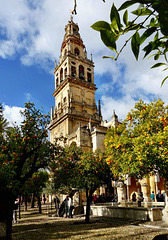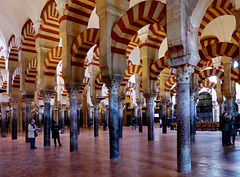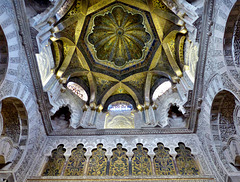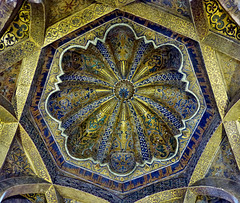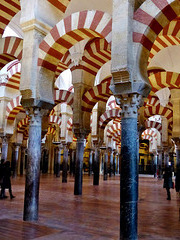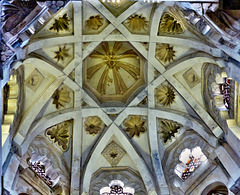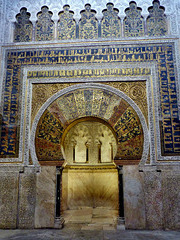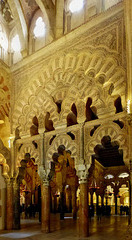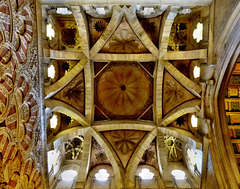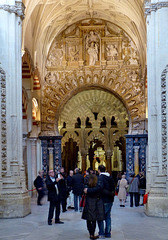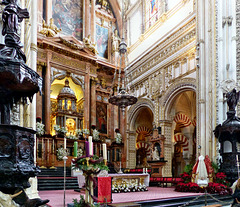
Córdoba
Córdoba - Mezquita-Catedral
| |
|
|
|
Córdoba shares its history with many cities in Southern Spain. It was Carthaginian and Roman (from 260BC on), later it belonged to the Byzantine Empire for two decades, was looted by the Vandals before the Visigoths conquered it in 572. In 711 it was taken by the by the Umayyad army and became a provincial capital.
At that time a Christian church erected by the Visigoths was on the site, it was divided and shared by Muslims and Christians. The sharing agreement lasted until 784 when the Christian half was purchased by Emir Abd al-Rahman I, who then demolished the church and started to build the grand mosque of Córdoba on its ground. This narrative goes back to the tenth-century historian al-Razi.
The work of building the Mezquita employed thousands of artisans and laborers. After the first completion, it underwent numerous subsequent changes: Abd al-Rahman II ordered a new minaret, and Al-Hakam II enlarged the building and enriched the Mihrab. The Mezquita reached its current dimensions in 987 with the completion of the outer naves and courtyard.
It covers an area of more than 23.000 m².
The Mezquita still is one of the largest sacred buildings on earth. In the 10th century it was in the center of Cordoba, that with a population of upto 500.000, at that time it was one of the largest cities in the known world.
Córdoba
| |
|
|
Córdoba shares its history with many cities in Southern Spain. It was Carthaginian and Roman (from 260BC on), later it belonged to the Byzantine Empire for two decades, was looted by the Vandals before the Visigoths conquered it in 572. In 711 it was taken by the by the Umayyad army and became a provincial capital.
Córdoba was captured by King Ferdinand III of Castile in 1236, after a siege of several months. The city declined over the next centuries and was partly destroyed and looted by French troops in 1808 during the Peninsular War.
Today Córdoba is a thriving city with a population of more than 300.000.
As I have already uploaded many photos from a previous visit, I will not add many now.
Córdoba - Torre de San Juan
| |
|
|
Córdoba shares its history with many cities in Southern Spain. It was Carthaginian and Roman (from 260BC on), later it belonged to the Byzantine Empire for two decades, was looted by the Vandals before the Visigoths conquered it in 572. In 711 it was taken by the by the Umayyad army and became a provincial capital.
Córdoba was captured by King Ferdinand III of Castile in 1236, after a siege of several months. The city declined over the next centuries and was partly destroyed and looted by French troops in 1808 during the Peninsular War.
Today Córdoba is a thriving city with a population of more than 300.000.
The Minaret of San Juan (aka "Torre de San Juan") was built end of the 9th or early 10th century and was then part of a mosque. It was probably higher than it is now. After the conquest of Cordoba, the place was ceded to the Knights Hospitaller (aka "of Saint John of Jerusalem"), who built a church on the ruins of the mosque.
As I have already uploaded many photos from a previous visit, I will not add many now.
Córdoba - Mezquita-Catedral
| |
|
|
Córdoba shares its history with many cities in Southern Spain. It was Carthaginian and Roman (from 260BC on), later it belonged to the Byzantine Empire for two decades, was looted by the Vandals before the Visigoths conquered it in 572. In 711 it was taken by the by the Umayyad army and became a provincial capital.
At that time a Christian church erected by the Visigoths was on the site, it was divided and shared by Muslims and Christians. The sharing agreement lasted until 784 when the Christian half was purchased by Emir Abd al-Rahman I, who then demolished the church and started to build the grand mosque of Córdoba on its ground. This narrative goes back to the tenth-century historian al-Razi.
The work of building the Mezquita employed thousands of artisans and laborers. After the first completion, it underwent numerous subsequent changes: Abd al-Rahman II ordered a new minaret, and Al-Hakam II enlarged the building and enriched the Mihrab. The Mezquita reached its current dimensions in 987 with the completion of the outer naves and courtyard.
It covers an area of more than 23.000 m².
The Mezquita still is one of the largest sacred buildings on earth. In the 10th century it was in the center of Cordoba, that with a population of upto 500.000, at that time it was one of the largest cities in the known world.
Córdoba - Mezquita-Catedral
| |
|
|
Córdoba shares its history with so many cities in Southern Spain. It was Carthaginian and Roman (from 260BC on), later it belonged to the Byzantine Empire for two decade, got looted by the Vandals, before Visigoths conquered it in 572. In 711 it was taken by the by the Umayyad army and became a provincial capital.
At that time a Christian church erected by the Visigoths was on the site, it was divided and shared by Muslims and Christians. The sharing agreement lastted until 784, when the Christian half was purchased by the Emir Abd al-Rahman I, who then demolished the church and started to build the grand mosque of Córdoba on its ground. This narrative goes back to the tenth-century historian al-Razi.
The work of building the Mezquita employed thousands of artisans and labourers. After vthe first completion it underwent numerous subsequent changes: Abd al-Rahman II ordered a new minaret, Al-Hakam II enlarged the building and enriched the Mihrab. The Mezquita reached its current dimensions in 987 with the completion of the outer naves and courtyard.
This sahn / courtyard, seen here, is today called "Patio de Naranjas". It was an important part of the Mezquita.
The Mezquita still is one of the largest sacred buildings on earth. In the 10th century it was in the center of Cordoba, that with a population of upto 500.000, at that time it was one of the largest cities in the known world.
Córdoba - Mezquita-Catedral
| |
|
|
Córdoba shares its history with so many cities in Southern Spain. It was Carthaginian and Roman (from 260BC on), later it belonged to the Byzantine Empire for two decade, got looted by the Vandals, before Visigoths conquered it in 572. In 711 it was taken by the by the Umayyad army and became a provincial capital.
At that time a Christian church erected by the Visigoths was on the site, it was divided and shared by Muslims and Christians. The sharing agreement lasted until 784, when the Christian half was purchased by the Emir Abd al-Rahman I, who then demolished the church and started to build the grand mosque of Córdoba on its ground. This narrative goes back to the tenth-century historian al-Razi.
The work of building the Mezquita employed thousands of artisans and labourers. After vthe first completion it underwent numerous subsequent changes: Abd al-Rahman II ordered a new minaret, Al-Hakam II enlarged the building and enriched the Mihrab. The Mezquita reached its current dimensions in 987 with the completion of the outer naves and courtyard.
It covers an area of more than 23.000 m².
The Mezquita still is one of the largest sacred buildings on earth. In the 10th century it was in the center of Cordoba, that with a population of upto 500.000, at that time it was one of the largest cities in the known world.
The brick-and-stone striped arches are supported by 856 granite and marble pillars, coming from Romans and Visigothic ruins.
Córdoba - Mezquita-Catedral
| |
|
|
Córdoba shares its history with so many cities in Southern Spain. It was Carthaginian and Roman (from 260BC on), later it belonged to the Byzantine Empire for two decade, got looted by the Vandals, before Visigoths conquered it in 572. In 711 it was taken by the by the Umayyad army and became a provincial capital.
At that time a Christian church erected by the Visigoths was on the site, it was divided and shared by Muslims and Christians. The sharing agreement lasted until 784, when the Christian half was purchased by the Emir Abd al-Rahman I, who then demolished the church and started to build the grand mosque of Córdoba on its ground. This narrative goes back to the tenth-century historian al-Razi.
The work of building the Mezquita employed thousands of artisans and labourers. After vthe first completion it underwent numerous subsequent changes: Abd al-Rahman II ordered a new minaret, Al-Hakam II enlarged the building and enriched the Mihrab. The Mezquita reached its current dimensions in 987 with the completion of the outer naves and courtyard.
It covers an area of more than 23.000 m².
The Mezquita still is one of the largest sacred buildings on earth. In the 10th century it was in the center of Cordoba, that with a population of upto 500.000, at that time it was one of the largest cities in the known world.
The brick-and-stone striped arches are supported by 856 granite and marble pillars, coming from Romans and Visigothic ruins.
Córdoba - Mezquita-Catedral
| |
|
Córdoba shares its history with so many cities in Southern Spain. It was Carthaginian and Roman (from 260BC on), later it belonged to the Byzantine Empire for two decade, got looted by the Vandals, before Visigoths conquered it in 572. In 711 it was taken by the by the Umayyad army and became a provincial capital.
At that time a Christian church erected by the Visigoths was on the site, it was divided and shared by Muslims and Christians. The sharing agreement lasted until 784, when the Christian half was purchased by the Emir Abd al-Rahman I, who then demolished the church and started to build the grand mosque of Córdoba on its ground. This narrative goes back to the tenth-century historian al-Razi.
The work of building the Mezquita employed thousands of artisans and labourers. After vthe first completion it underwent numerous subsequent changes: Abd al-Rahman II ordered a new minaret, Al-Hakam II enlarged the building and enriched the Mihrab. The Mezquita reached its current dimensions in 987 with the completion of the outer naves and courtyard.
It covers an area of more than 23.000 m².
The Mezquita still is one of the largest sacred buildings on earth. In the 10th century it was in the center of Cordoba, that with a population of upto 500.000, at that time it was one of the largest cities in the known world.
The brick-and-stone striped arches are supported by 856 granite and marble pillars, coming from Romans and Visigothic ruins.
Córdoba - Mezquita-Catedral
| |
|
Córdoba shares its history with so many cities in Southern Spain. It was Carthaginian and Roman (from 260BC on), later it belonged to the Byzantine Empire for two decade, got looted by the Vandals, before Visigoths conquered it in 572. In 711 it was taken by the by the Umayyad army and became a provincial capital.
At that time a Christian church erected by the Visigoths was on the site, it was divided and shared by Muslims and Christians. The sharing agreement lasted until 784, when the Christian half was purchased by the Emir Abd al-Rahman I, who then demolished the church and started to build the grand mosque of Córdoba on its ground. This narrative goes back to the tenth-century historian al-Razi.
The work of building the Mezquita employed thousands of artisans and labourers. After the first completion it underwent numerous subsequent changes: Abd al-Rahman II ordered a new minaret, Al-Hakam II enlarged the building and enriched the Mihrab. The Mezquita reached its current dimensions in 987 with the completion of the outer naves and courtyard.
It covers an area of more than 23.000 m².
The Mezquita still is one of the largest sacred buildings on earth. In the 10th century it was in the center of Cordoba, that with a population of upto 500.000, at that time it was one of the largest cities in the known world.
Córdoba - Mezquita-Catedral
| |
|
|
|
Córdoba shares its history with so many cities in Southern Spain. It was Carthaginian and Roman (from 260BC on), later it belonged to the Byzantine Empire for two decade, got looted by the Vandals, before Visigoths conquered it in 572. In 711 it was taken by the by the Umayyad army and became a provincial capital.
At that time a Christian church erected by the Visigoths was on the site, it was divided and shared by Muslims and Christians. The sharing agreement lasted until 784, when the Christian half was purchased by the Emir Abd al-Rahman I, who then demolished the church and started to build the grand mosque of Córdoba on its ground. This narrative goes back to the tenth-century historian al-Razi.
The work of building the Mezquita employed thousands of artisans and labourers. After the first completion it underwent numerous subsequent changes: Abd al-Rahman II ordered a new minaret, Al-Hakam II enlarged the building and enriched the Mihrab. The Mezquita reached its current dimensions in 987 with the completion of the outer naves and courtyard.
It covers an area of more than 23.000 m².
The Mezquita still is one of the largest sacred buildings on earth. In the 10th century it was in the center of Cordoba, that with a population of upto 500.000, at that time it was one of the largest cities in the known world.
Córdoba - Mezquita-Catedral
| |
|
|
|
Córdoba shares its history with so many cities in Southern Spain. It was Carthaginian and Roman (from 260BC on), later it belonged to the Byzantine Empire for two decade, got looted by the Vandals, before Visigoths conquered it in 572. In 711 it was taken by the by the Umayyad army and became a provincial capital.
At that time a Christian church erected by the Visigoths was on the site, it was divided and shared by Muslims and Christians. The sharing agreement lasted until 784, when the Christian half was purchased by the Emir Abd al-Rahman I, who then demolished the church and started to build the grand mosque of Córdoba on its ground. This narrative goes back to the tenth-century historian al-Razi.
The work of building the Mezquita employed thousands of artisans and labourers. After the first completion it underwent numerous subsequent changes: Abd al-Rahman II ordered a new minaret, Al-Hakam II enlarged the building and enriched the Mihrab. The Mezquita reached its current dimensions in 987 with the completion of the outer naves and courtyard.
It covers an area of more than 23.000 m².
The Mezquita still is one of the largest sacred buildings on earth. In the 10th century it was in the center of Cordoba, that with a population of upto 500.000, at that time it was one of the largest cities in the known world.
The brick-and-stone striped arches are supported by 856 granite and marble pillars, coming from Romans and Visigothic ruins.
Córdoba - Mezquita-Catedral
| |
|
|
Córdoba shares its history with so many cities in Southern Spain. It was Carthaginian and Roman (from 260BC on), later it belonged to the Byzantine Empire for two decade, got looted by the Vandals, before Visigoths conquered it in 572. In 711 it was taken by the by the Umayyad army and became a provincial capital.
At that time a Christian church erected by the Visigoths was on the site, it was divided and shared by Muslims and Christians. The sharing agreement lasted until 784, when the Christian half was purchased by the Emir Abd al-Rahman I, who then demolished the church and started to build the grand mosque of Córdoba on its ground. This narrative goes back to the tenth-century historian al-Razi.
The work of building the Mezquita employed thousands of artisans and labourers. After the first completion it underwent numerous subsequent changes: Abd al-Rahman II ordered a new minaret, Al-Hakam II enlarged the building and enriched the Mihrab. The Mezquita reached its current dimensions in 987 with the completion of the outer naves and courtyard.
It covers an area of more than 23.000 m².
The Mezquita still is one of the largest sacred buildings on earth. In the 10th century it was in the center of Cordoba, that with a population of upto 500.000, at that time it was one of the largest cities in the known world.
Córdoba - Mezquita-Catedral
| |
|
|
Córdoba shares its history with so many cities in Southern Spain. It was Carthaginian and Roman (from 260BC on), later it belonged to the Byzantine Empire for two decade, got looted by the Vandals, before Visigoths conquered it in 572. In 711 it was taken by the by the Umayyad army and became a provincial capital.
At that time a Christian church erected by the Visigoths was on the site, it was divided and shared by Muslims and Christians. The sharing agreement lasted until 784, when the Christian half was purchased by the Emir Abd al-Rahman I, who then demolished the church and started to build the grand mosque of Córdoba on its ground. This narrative goes back to the tenth-century historian al-Razi.
The work of building the Mezquita employed thousands of artisans and labourers. After the first completion it underwent numerous subsequent changes: Abd al-Rahman II ordered a new minaret, Al-Hakam II enlarged the building and enriched the Mihrab (seen here). The Mezquita reached its current dimensions in 987 with the completion of the outer naves and courtyard.
It covers an area of more than 23.000 m².
The Mezquita still is one of the largest sacred buildings on earth. In the 10th century it was in the center of Cordoba, that with a population of upto 500.000, at that time it was one of the largest cities in the known world.
The mirhab is a shell-shaped prayer niche, built in the 10th century. The mihrab traditionally faces Mecca. However, the Mosque of Cordoba’s mihrab faces south and not south-east, where Mecca is supposed to be.
Sculptors from Byzanz imported the gold cubes. It was built in a small room to amplify the words of the imam.
Córdoba - Mezquita-Catedral
| |
|
Córdoba shares its history with so many cities in Southern Spain. It was Carthaginian and Roman (from 260BC on), later it belonged to the Byzantine Empire for two decade, got looted by the Vandals, before Visigoths conquered it in 572. In 711 it was taken by the by the Umayyad army and became a provincial capital.
At that time a Christian church erected by the Visigoths was on the site, it was divided and shared by Muslims and Christians. The sharing agreement lasted until 784, when the Christian half was purchased by the Emir Abd al-Rahman I, who then demolished the church and started to build the grand mosque of Córdoba on its ground. This narrative goes back to the tenth-century historian al-Razi.
The work of building the Mezquita employed thousands of artisans and labourers. After the first completion it underwent numerous subsequent changes: Abd al-Rahman II ordered a new minaret, Al-Hakam II enlarged the building and enriched the Mihrab. The Mezquita reached its current dimensions in 987 with the completion of the outer naves and courtyard.
It covers an area of more than 23.000 m².
The Mezquita still is one of the largest sacred buildings on earth. In the 10th century it was in the center of Cordoba, that with a population of upto 500.000, at that time it was one of the largest cities in the known world.
Córdoba - Mezquita-Catedral
| |
|
Córdoba shares its history with so many cities in Southern Spain. It was Carthaginian and Roman (from 260BC on), later it belonged to the Byzantine Empire for two decade, got looted by the Vandals, before Visigoths conquered it in 572. In 711 it was taken by the by the Umayyad army and became a provincial capital.
At that time a Christian church erected by the Visigoths was on the site, it was divided and shared by Muslims and Christians. The sharing agreement lasted until 784, when the Christian half was purchased by the Emir Abd al-Rahman I, who then demolished the church and started to build the grand mosque of Córdoba on its ground. This narrative goes back to the tenth-century historian al-Razi.
The work of building the Mezquita employed thousands of artisans and labourers. After the first completion it underwent numerous subsequent changes: Abd al-Rahman II ordered a new minaret, Al-Hakam II enlarged the building and enriched the Mihrab. The Mezquita reached its current dimensions in 987 with the completion of the outer naves and courtyard.
It covers an area of more than 23.000 m².
The Mezquita still is one of the largest sacred buildings on earth. In the 10th century it was in the center of Cordoba, that with a population of upto 500.000, at that time it was one of the largest cities in the known world.
Córdoba - Mezquita-Catedral
| |
|
|
Córdoba shares its history with so many cities in Southern Spain. It was Carthaginian and Roman (from 260BC on), later it belonged to the Byzantine Empire for two decade, got looted by the Vandals, before Visigoths conquered it in 572. In 711 it was taken by the by the Umayyad army and became a provincial capital.
At that time a Christian church erected by the Visigoths was on the site, it was divided and shared by Muslims and Christians. The sharing agreement lasted until 784, when the Christian half was purchased by the Emir Abd al-Rahman I, who then demolished the church and started to build the grand mosque of Córdoba on its ground. This narrative goes back to the tenth-century historian al-Razi.
The work of building the Mezquita employed thousands of artisans and labourers. After the first completion it underwent numerous subsequent changes: Abd al-Rahman II ordered a new minaret, Al-Hakam II enlarged the building and enriched the Mihrab. The Mezquita reached its current dimensions in 987 with the completion of the outer naves and courtyard.
It covers an area of more than 23.000 m².
The Mezquita still is one of the largest sacred buildings on earth. In the 10th century it was in the center of Cordoba, that with a population of upto 500.000, at that time it was one of the largest cities in the known world.
Córdoba - Mezquita-Catedral
| |
|
|
|
Córdoba shares its history with so many cities in Southern Spain. It was Carthaginian and Roman (from 260BC on), later it belonged to the Byzantine Empire for two decade, got looted by the Vandals, before Visigoths conquered it in 572. In 711 it was taken by the by the Umayyad army and became a provincial capital.
At that time a Christian church erected by the Visigoths was on the site, it was divided and shared by Muslims and Christians. The sharing agreement lasted until 784, when the Christian half was purchased by the Emir Abd al-Rahman I, who then demolished the church and started to build the grand mosque of Córdoba on its ground. This narrative goes back to the tenth-century historian al-Razi.
The work of building the Mezquita employed thousands of artisans and labourers. After the first completion it underwent numerous subsequent changes: Abd al-Rahman II ordered a new minaret, Al-Hakam II enlarged the building and enriched the Mihrab. The Mezquita reached its current dimensions in 987 with the completion of the outer naves and courtyard.
It covers an area of more than 23.000 m².
The Mezquita still is one of the largest sacred buildings on earth. In the 10th century it was in the center of Cordoba, that with a population of upto 500.000, at that time it was one of the largest cities in the known world.
After in 1236 Córdoba was captured from the Moors, the Christians initially left the architecture Mezquita undisturbed.
The just consecrated it, dedicated it to the Virgin Mary, and used it as a place of Christian worship. Later small chapels were inserted and the the minaret was converted into a the bell tower of the cathedral.
The most significant alteration was the building of a Renaissance cathedral in a cruciform layout right ine center of the former mosque. The insertion was constructed by permission of Charles V, King of Castile and Aragon.
The legend tells, that upon seeing it completed, he remarked, "You have built here what you or anyone might have built anywhere else, but you have destroyed what was unique in the world."
Here in the foreground is an arch, belonging the the "new" cathedral, while in the backdrop is a part of the "old" mosque.
Córdoba - Mezquita-Catedral
| |
|
|
Córdoba shares its history with so many cities in Southern Spain. It was Carthaginian and Roman (from 260BC on), later it belonged to the Byzantine Empire for two decade, got looted by the Vandals, before Visigoths conquered it in 572. In 711 it was taken by the by the Umayyad army and became a provincial capital.
At that time a Christian church erected by the Visigoths was on the site, it was divided and shared by Muslims and Christians. The sharing agreement lasted until 784, when the Christian half was purchased by the Emir Abd al-Rahman I, who then demolished the church and started to build the grand mosque of Córdoba on its ground. This narrative goes back to the tenth-century historian al-Razi.
The work of building the Mezquita employed thousands of artisans and labourers. After the first completion it underwent numerous subsequent changes: Abd al-Rahman II ordered a new minaret, Al-Hakam II enlarged the building and enriched the Mihrab. The Mezquita reached its current dimensions in 987 with the completion of the outer naves and courtyard.
It covers an area of more than 23.000 m².
The Mezquita still is one of the largest sacred buildings on earth. In the 10th century it was in the center of Cordoba, that with a population of upto 500.000, at that time it was one of the largest cities in the known world.
After in 1236 Córdoba was captured from the Moors, the Christians initially left the architecture Mezquita undisturbed.
They just consecrated it, dedicated it to the Virgin Mary, and used it as a place of Christian worship. Later small chapels were inserted and the the minaret was converted into a the bell tower of the cathedral.
The most significant alteration was the building of a Renaissance cathedral in a cruciform layout right in the center of the former mosque. The insertion was constructed by permission of Charles V, King of Castile and Aragon.
The legend tells, that upon seeing it completed, he remarked, "You have built here what you or anyone might have built anywhere else, but you have destroyed what was unique in the world."
Jump to top
RSS feed- Latest items - Subscribe to the latest items added to this album
- ipernity © 2007-2024
- Help & Contact
|
Club news
|
About ipernity
|
History |
ipernity Club & Prices |
Guide of good conduct
Donate | Group guidelines | Privacy policy | Terms of use | Statutes | In memoria -
Facebook
Twitter





